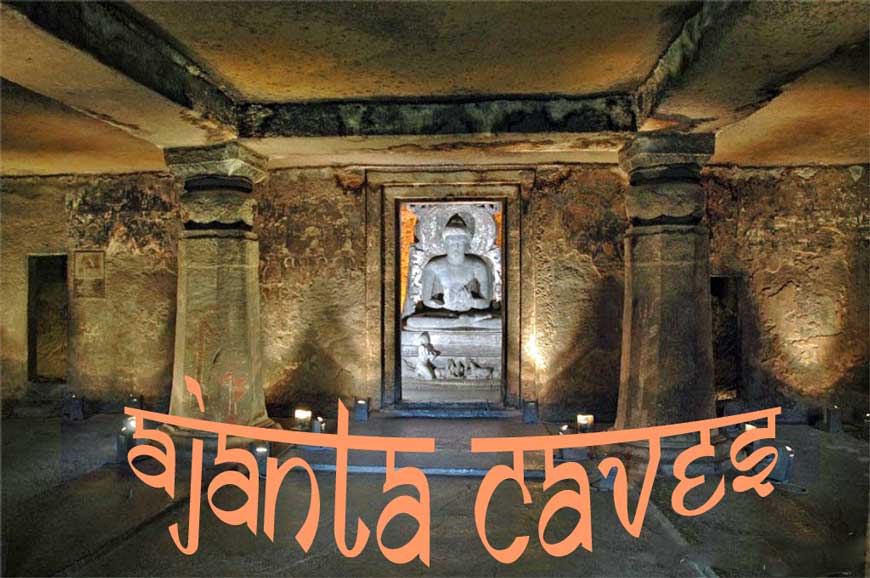One day in the year 1819 some British soldiers were going on a tiger
shoot in the hills. Suddenly one of them spied a semi-circular,
moon-shaped scarp overlooking a narrow gorge through which ran the
Waghora River. Intrigued by this they made their way across the ravine
and climbed up to the scarp and discovered several caves camouflaged by
bushes, shrubs and earth. Some goatherds seemed to be using these caves
for shelter. One of them went inside a cave and peering into the
darkness made out the forms of these incredible paintings. We can
imagine how excited he must have been. He ran back and told the others
who trouped in to see this wonder. They informed the government and of
course the rest is history. The caves hit the international news and
people started flocking to them.
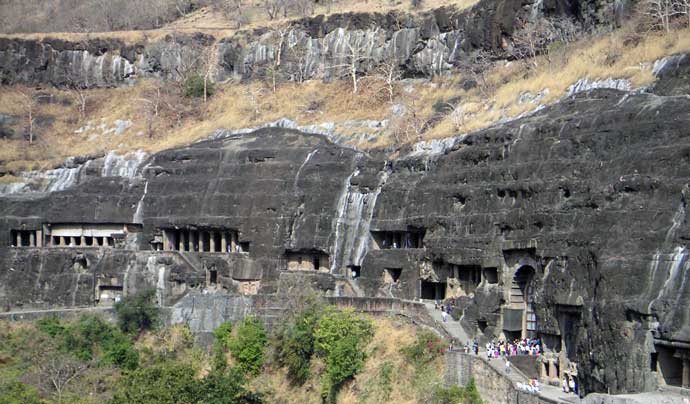
The undisturbed slumber of centuries vanished. Very soon the whole of
the art world was queuing up to see these wondrous paintings. They have
won international fame for being the most perfect specimens of Indian
mural art. They gave an impetus to Indian art revival in the beginning
of the 20th century. We can imagine that they must also have influenced
the art tradition of Central Asia many centuries ago.
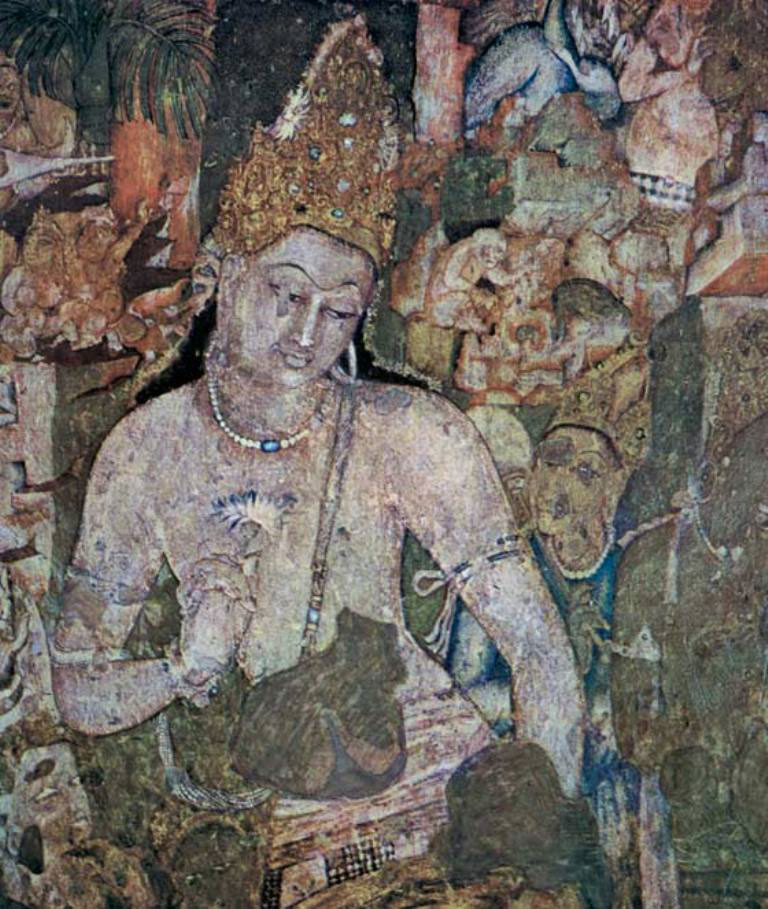 Padmapani: Bearer of the lotus Bodhisattva
Padmapani: Bearer of the lotus Bodhisattva
Ajanta is a three-hour drive from Ellora and we reached there quite
early in the morning after passing through a lovely winding road
overlooking the valley. There were quite a few boys carrying dolies,
which are a kind of sling baskets in which old people or lazy people
can sit and be carried up the hill. The caves were quite high on a kind
of ledge and it was an arduous climb. Once having reached the top you
had to go from cave to cave which also posed a problem for the
physically unfit since the ledge was uneven even though it had been
cemented recently. I doubt if there was any path connecting the caves
when they were made. A cemented path has now been constructed which
connects most of the caves. The boys looked pleadingly at me since I was
obviously a possible catch but I cheerfully shook them off. Some of
them stayed behind me hoping to catch me as I fell as they were sure I
would do, but though I’m not a fast walker, I’m a plodder and somehow
managed to climb up with a bit of huffing and puffing!
 Bodhisattva
Bodhisattva
Unlike the ones at Ellora these caves were all Buddhist caves and date from 200 BC. The Chinese Buddhist travelers Hiuen Tsang and Fa Hien have made references to these caves which they came across during their travels.
The caves are unique in that they combine three forms of art—architecture, sculpture and painting.
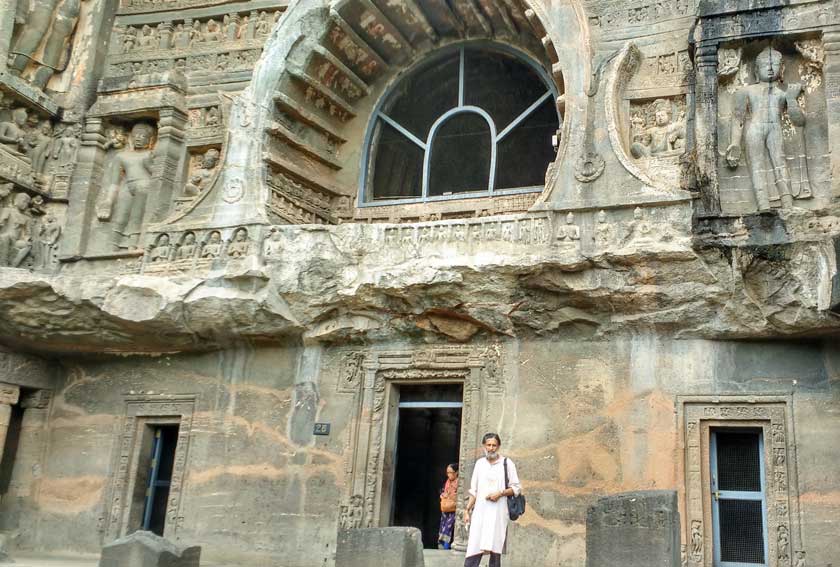
A feeling of awe enveloped me as I entered the first cave and I felt I
was entering a temple. I was happy that they had asked us to take off
our footwear before entering. The cave was dark as I entered but all the
caves had special lighting, spotlighting the magnificent paintings. The
first thing I saw on the opposite wall beside the antechamber were the
towering figures of the Bodhisattvas which are most famous of all the
paintings here since we see their reproductions everywhere. These are
indeed the masterpieces of the world. The one on the left holds a lily.
His consort who is dark in color, and who is known as the “Dark
Princess”, also holds a lily. Between them is the whisk bearer. Although
they are huge, their faces are filled with compassion. Around them were
some divine musicians and flying figures. In the right corner there
were a set of monkeys jumping about, some peacocks and a happy couple.
In the midst of this moving and rejoicing world they seemed to be
standing aloof, filled with peace due to their inner realization. Their
half closed eyelids show their absorption in their inner world.
Dharma Chakra Pravartana Mudra
I was transfixed with the beauty of these figures and could have sat
there forever looking at them or looking through them to the artists who
conceived such beauty. Who were their models or did they work only
through imagination? Actually opposite the entrance is the sanctum in
which there is a colossal figure of the Buddha seated in the preaching
attitude with the “dharma chakra pravartana mudra” which is the one we
normally see on all statues of the Buddha when he is preaching. In this
mudra his right hand has the jnana mudra in which the forefinger is
touching the thumb. The little finger of the left hand is hooked on to
the thumb thus showing that one has to hang on to the Dharma which is
the only escape from this wheel of samsara. On one of the two central
columns on the right are four deer with only one head but the figure has
been done so cleverly that anywhere you look you will find that there
is a deer with four legs! While on this type of trick painting let me
mention that in one of the last caves there were also some two dimensional
and three dimensional faces. This means that the two dimensional face would
appear to turn and look at you when you went to one side. In the three
dimensional one it looked straight at you when you stood in front and
the eyes seemed to swivel round when you went to the left and again to
the right. I was also amazed to see the intricate carving of beautiful
rosettes on the ceiling. Apparently every inch of this cave had
originally been painted – the pillars, the figures, the ceiling and the
walls. Unfortunately much of it has peeled off but even then we can
imagine their pristine grandeur. How did they paint such exquisite
figures on the rough walls of a cave?
They used a very special technique. First they plastered the rough
surfaces of the walls and ceilings with a layer of clay mixed with
cow-dung and rice-husks. Sometimes they used brick powder mixed with
paddy husk, grass and other material of organic origin. Next a second
coat of mud mixed with rock powder or sand and fine fibrous material was
applied to it. The surface was finally given a thin coat of lime wash
and the surface was kept moist when the colors were applied. The
outlines were first drawn in red. All the colors except blue were got
from the neighboring hills. I suppose the figures were mainly from
imagination and described the stories from the Jatakas or scenes from
the life of the Buddha.
Another thing which struck me was the beauty of the ceilings which had
such detailed paintings of chakras and other flower motifs. How did they
ever do it? I was told that their methodology could be discovered
through the few unfinished caves. Apparently they worked from the top to
the bottom. They would hack out some of the rock from the top of the
cave and then use that as a scaffolding on which they could lie with
perfect ease and work on the intricate designs of the ceilings! It was
only after the ceiling was finished that they would hack the rock until
they reached the floor of the cave.
After going to all the other caves I realized that Cave one was really the
most splendid. It would take at least a week to see everything in this
cave. Most of the caves had the Buddha seated at the back in the
teaching posture. Cave two was similar to cave one. The side walls were
all painted with a thousand different Buddhas. One of the things which
struck me was the fact that many of the ceilings emulated wooden beams
and rafters all cut out of the rock! On either side of the big caves
were little cubicles in which the students obviously stayed. Cave seven has
innumerable Buddhas carved in different postures.
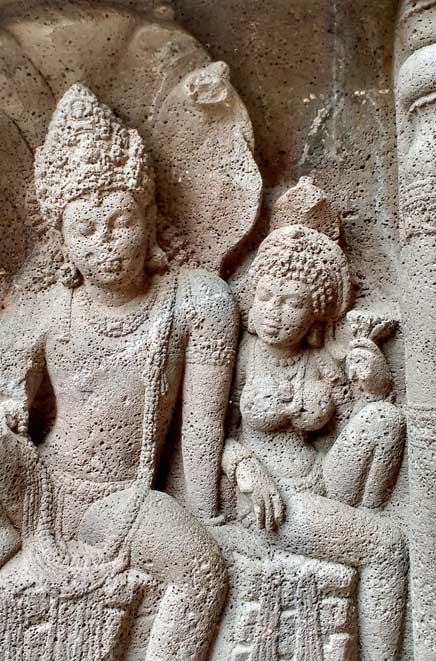
The Buddha had particularly asked his followers not to keep any idols of
any kind and forbade any images of himself to be worshiped but the
human heart yearns for some symbol on which to pour out his love and
very soon after his Samadhi his devotees started carving wondrous
statues and paintings of him. Another historical fact is that after his
Samadhi, many aboriginals became his followers and they wanted to
worship him as the Hindus worshiped idols. The monks made up many
stories of the Buddha’s previous incarnations. He had also told his
disciples stories of his previous births. Slowly Buddhism split into two
groups, the Hinayana or those who denied any type of pleasure and who
practiced the eight-fold path of right behavior and the Mahayana or
those who accepted the fact that world is filled with desire but also
remembered the fact that the world is filled with pain. Under the
insidious influence of Hinduism the Mahayana made Buddha himself into a
god and started to accept women in the Sangha which had been forbidden
by the Master. We can imagine that by the time when the caves were
painted the Buddhists had evolved an imagery which was as complicated as
Hindu pantheon.
On the opposite side of the horseshoe we came to cave sixteen which has a
large statue of the preaching Buddha. The last cave, twenty-six had a
magnificent piece of the Buddha on his Samadhi bed, surrounded by his
disciples. Three of his main disciples stand at the feet and his favorite disciple, Ananda stands apart weeping.
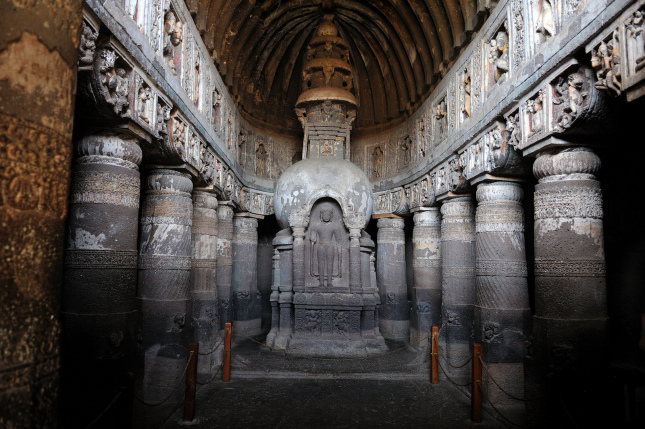
Instead of returning the same way along the caves we chose the path
which went down to the river. Right down at the bottom we had to cross a
wooden bridge, on the right side of which, was a striking waterfall
which must have been seasonal. We followed the small track which ran
along the side of the river which took us back to the first point where
we had chosen the difficult path leading straight to the caves. It was a
beautiful walk, with lush green plants and bushes on either side. There
were many Sornali trees dotted amidst the green and they made brilliant
splashes of color since they were in full bloom.
The whole place must have been a thick forest during the time when the
monks came to find a retreat for themselves. One can only marvel at the
faith and tenacity of these people who were prepared to push through the
jungle, perhaps infested with snakes and wild animals until they
reached the ledge and the rock face where they decided to make this
fantastic haven.
Hari Aum Tat Sat
|
